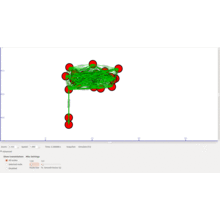How to Begin Implementing a Vertical Handover Projects in NS3
To begin performing a Vertical Handover (VHO) project using ns3 which has numerous steps since it needs to replicate the heterogeneous networks such as WiFi, LTE, and 5G and handover decision mechanisms. Here’s a structured approach to get started:
Steps to Begin Implementing a Vertical Handover Projects in NS3
Step 1: Understand Vertical Handover Concepts
- Vertical Handover:
- Transition among diverse kinds of networks such as LTE to WiFi or WiFi to 5G.
- It needs network heterogeneity and handover management.
- Key Components:
- Network Interfaces: Various network technologies such as WiFi, LTE, and 5G.
- Handover Decision Algorithm: It depends on the signal strength (RSSI), network load, delay, or QoS parameters.
- Mobility Management: For monitoring and handling the nodes mobility.
Step 2: Install ns3 and Relevant Modules
- Download ns3:
- We should download and install NS3 on the system.
- Enable LTE and WiFi Modules:
- During configuration, make sure these components are allowed:
./waf configure –enable-modules=lte,wifi,mobility
./waf build
- Verify Installation:
- Execute a sample instance scripts to confirm the set up:
./waf –run lte-simple
./waf –run wifi-simple-infra
Step 3: Define the Project Scope
- Scenario:
- Replicate a user device which is transferring among the WiFi and LTE networks.
- Performance Metrics:
- Handover latency, throughput, packet loss, or QoS are performance indicators.
- Decision Criteria:
- RSSI, latency, bandwidth, or user preferences.
Step 4: Set Up the Simulation Environment
- Create Nodes:
- Integrate nodes to specify the User Equipment (UE), access points (APs), and eNodeBs.
NodeContainer ueNodes;
ueNodes.Create(1);
NodeContainer wifiApNodes;
wifiApNodes.Create(1);
NodeContainer lteEnbNodes;
lteEnbNodes.Create(1);
- Install Network Stacks:
- Make use of WiFi, LTE, and Internet stack components.
InternetStackHelper stack;
stack.Install(ueNodes);
stack.Install(wifiApNodes);
stack.Install(lteEnbNodes);
- Configure Mobility:
- Replicate the node movement with the support of a mobility pattern.
MobilityHelper mobility;
mobility.SetMobilityModel(“ns3::ConstantVelocityMobilityModel”);
mobility.Install(ueNodes);
ueNodes.Get(0)->GetObject<ConstantVelocityMobilityModel>()->SetVelocity(Vector(10.0, 0.0, 0.0));
Step 5: Configure Network Technologies
- WiFi Network:
- Configure a WiFi access point and link it to the UE.
WifiHelper wifi;
wifi.SetStandard(WIFI_PHY_STANDARD_80211n);
YansWifiPhyHelper phy = YansWifiPhyHelper::Default();
YansWifiChannelHelper channel = YansWifiChannelHelper::Default();
phy.SetChannel(channel.Create());
WifiMacHelper mac;
Ssid ssid = Ssid(“ns3-ssid”);
mac.SetType(“ns3::StaWifiMac”, “Ssid”, SsidValue(ssid));
NetDeviceContainer wifiDevices = wifi.Install(phy, mac, ueNodes);
- LTE Network:
- Configure an LTE eNodeB and associated it to the UE.
Ptr<LteHelper> lteHelper = CreateObject<LteHelper>();
Ptr<PointToPointEpcHelper> epcHelper = CreateObject<PointToPointEpcHelper>();
lteHelper->SetEpcHelper(epcHelper);
NetDeviceContainer lteEnbDevices = lteHelper->InstallEnbDevice(lteEnbNodes);
NetDeviceContainer lteUeDevices = lteHelper->InstallUeDevice(ueNodes);
lteHelper->Attach(lteUeDevices, lteEnbDevices.Get(0));
Step 6: Implement the Handover Algorithm
- Trigger Handover Events:
- Choose handover that cause the events to leverage signal strength (RSSI) or other parameters.
Simulator::Schedule(Seconds(5.0), &LteHelper::HandoverRequest, lteHelper, Seconds(5.0),
lteUeDevices.Get(0), lteEnbDevices.Get(0), lteEnbDevices.Get(1));
- Custom Decision Algorithm:
- Create a function for dynamically observing parameters and activate handover.
void MonitorAndTriggerHandover() {
double rssiWifi = GetWifiRssi(ueNodes.Get(0));
double rssiLte = GetLteRssi(ueNodes.Get(0));
if (rssiWifi > rssiLte) {
// Connect to WiFi
wifiHelper->AssociateToAp(wifiDevices.Get(0), wifiApNodes.Get(0));
} else {
// Connect to LTE
lteHelper->Attach(lteUeDevices.Get(0), lteEnbDevices.Get(0));
}
}
- Use Callbacks:
- Utilize ns3 callback approaches for observing the events such as signal strength changes.
Step 7: Collect and Analyze Results
- Install Applications:
- Make traffic such as UDP or TCP to estimate the performance.
UdpEchoServerHelper echoServer(9);
ApplicationContainer serverApps = echoServer.Install(wifiApNodes.Get(0));
serverApps.Start(Seconds(1.0));
serverApps.Stop(Seconds(20.0));
UdpEchoClientHelper echoClient(serverAddress, 9);
echoClient.SetAttribute(“MaxPackets”, UintegerValue(100));
echoClient.SetAttribute(“Interval”, TimeValue(Seconds(0.1)));
echoClient.SetAttribute(“PacketSize”, UintegerValue(1024));
ApplicationContainer clientApps = echoClient.Install(ueNodes.Get(0));
clientApps.Start(Seconds(2.0));
clientApps.Stop(Seconds(20.0));
- Use FlowMonitor:
- Accumulate the performance parameters like throughput, packet loss, and delay.
Ptr<FlowMonitor> flowMonitor;
FlowMonitorHelper flowHelper;
flowMonitor = flowHelper.InstallAll();
- Visualize Results:
- To envision the outcomes with the support of Gnuplot or NetAnim tools.
Step 8: Debug and Optimize
- Allow logging to debug:
export NS_LOG=”UdpEchoClientApplication=level_all|prefix_time”
./waf –run your-script-name
- Enhance the handover decision logic and replicate various circumstances.
The implementation approach to Vertical Handover project is presented in an organized manner, which were simulated and analyzed using NS3 environment and we are furnished to expand on it if desired.

 Click Here to watch our latest output video using NS3 simulator
Click Here to watch our latest output video using NS3 simulator  Click Here to watch our latest projects screenshots using NS3 simulator
Click Here to watch our latest projects screenshots using NS3 simulator